[English] 日本語
 Yorodumi
Yorodumi- PDB-2mlq: Human CCR2 Membrane-Proximal C-Terminal Region (PRO-C) in a froun... -
+ Open data
Open data
- Basic information
Basic information
| Entry | Database: PDB / ID: 2mlq | ||||||
|---|---|---|---|---|---|---|---|
| Title | Human CCR2 Membrane-Proximal C-Terminal Region (PRO-C) in a frount bound form | ||||||
 Components Components | MCP-1 receptor | ||||||
 Keywords Keywords |  SIGNALING PROTEIN / CCR2 / PRO-C / FROUNT SIGNALING PROTEIN / CCR2 / PRO-C / FROUNT | ||||||
| Function / homology |  Function and homology information Function and homology informationT-helper 17 cell chemotaxis / chemokine (C-C motif) ligand 2 binding / chemokine (C-C motif) ligand 12 binding / negative regulation of eosinophil degranulation / positive regulation of immune complex clearance by monocytes and macrophages / positive regulation of CD8-positive, alpha-beta T cell extravasation / positive regulation of astrocyte chemotaxis / leukocyte adhesion to vascular endothelial cell / chemokine (C-C motif) ligand 7 binding / positive regulation of thymocyte migration ...T-helper 17 cell chemotaxis / chemokine (C-C motif) ligand 2 binding / chemokine (C-C motif) ligand 12 binding / negative regulation of eosinophil degranulation / positive regulation of immune complex clearance by monocytes and macrophages / positive regulation of CD8-positive, alpha-beta T cell extravasation / positive regulation of astrocyte chemotaxis / leukocyte adhesion to vascular endothelial cell / chemokine (C-C motif) ligand 7 binding / positive regulation of thymocyte migration / positive regulation of hematopoietic stem cell migration / monocyte extravasation / CCR2 chemokine receptor binding / negative regulation of type 2 immune response / regulation of vascular endothelial growth factor production / positive regulation of NMDA glutamate receptor activity /  Beta defensins / positive regulation of monocyte extravasation / macrophage migration / regulation of T cell cytokine production / regulation of macrophage migration / neutrophil clearance / positive regulation of leukocyte tethering or rolling / Beta defensins / positive regulation of monocyte extravasation / macrophage migration / regulation of T cell cytokine production / regulation of macrophage migration / neutrophil clearance / positive regulation of leukocyte tethering or rolling /  chemokine receptor activity / positive regulation of T-helper 1 type immune response / inflammatory response to wounding / positive regulation of T cell chemotaxis / positive regulation of alpha-beta T cell proliferation / C-C chemokine receptor activity / C-C chemokine binding / negative regulation of adenylate cyclase activity / cellular homeostasis / chemokine-mediated signaling pathway / positive regulation of monocyte chemotaxis / Chemokine receptors bind chemokines / dendritic cell chemotaxis / regulation of T cell differentiation / Interleukin-10 signaling / monocyte chemotaxis / cell surface receptor signaling pathway via JAK-STAT / chemokine receptor activity / positive regulation of T-helper 1 type immune response / inflammatory response to wounding / positive regulation of T cell chemotaxis / positive regulation of alpha-beta T cell proliferation / C-C chemokine receptor activity / C-C chemokine binding / negative regulation of adenylate cyclase activity / cellular homeostasis / chemokine-mediated signaling pathway / positive regulation of monocyte chemotaxis / Chemokine receptors bind chemokines / dendritic cell chemotaxis / regulation of T cell differentiation / Interleukin-10 signaling / monocyte chemotaxis / cell surface receptor signaling pathway via JAK-STAT /  humoral immune response / humoral immune response /  hemopoiesis / blood vessel remodeling / cellular defense response / homeostasis of number of cells within a tissue / sensory perception of pain / positive regulation of interleukin-2 production / cell chemotaxis / negative regulation of angiogenesis / positive regulation of synaptic transmission, glutamatergic / calcium-mediated signaling / intracellular calcium ion homeostasis / hemopoiesis / blood vessel remodeling / cellular defense response / homeostasis of number of cells within a tissue / sensory perception of pain / positive regulation of interleukin-2 production / cell chemotaxis / negative regulation of angiogenesis / positive regulation of synaptic transmission, glutamatergic / calcium-mediated signaling / intracellular calcium ion homeostasis /  fibrillar center / positive regulation of inflammatory response / response to wounding / cytokine-mediated signaling pathway / fibrillar center / positive regulation of inflammatory response / response to wounding / cytokine-mediated signaling pathway /  chemotaxis / positive regulation of T cell activation / positive regulation of type II interferon production / positive regulation of tumor necrosis factor production / positive regulation of cold-induced thermogenesis / positive regulation of cytosolic calcium ion concentration / G alpha (i) signalling events / chemotaxis / positive regulation of T cell activation / positive regulation of type II interferon production / positive regulation of tumor necrosis factor production / positive regulation of cold-induced thermogenesis / positive regulation of cytosolic calcium ion concentration / G alpha (i) signalling events /  regulation of inflammatory response / regulation of inflammatory response /  perikaryon / perikaryon /  immune response / immune response /  inflammatory response / external side of plasma membrane / inflammatory response / external side of plasma membrane /  dendrite / neuronal cell body / perinuclear region of cytoplasm / dendrite / neuronal cell body / perinuclear region of cytoplasm /  membrane / identical protein binding / membrane / identical protein binding /  plasma membrane / plasma membrane /  cytosol / cytosol /  cytoplasm cytoplasmSimilarity search - Function | ||||||
| Biological species |   Homo sapiens (human) Homo sapiens (human) | ||||||
| Method |  SOLUTION NMR SOLUTION NMR | ||||||
| Model details | lowest energy, model1 | ||||||
 Authors Authors | Esaki, K. / Yoshinaga, S. / Tsuji, T. / Toda, E. / Terashima, Y. / Saitoh, T. / Kohda, D. / Kohno, T. / Osawa, M. / Ueda, T. ...Esaki, K. / Yoshinaga, S. / Tsuji, T. / Toda, E. / Terashima, Y. / Saitoh, T. / Kohda, D. / Kohno, T. / Osawa, M. / Ueda, T. / Shimada, I. / Matsushima, K. / Terasawa, H. | ||||||
 Citation Citation |  Journal: Febs J. / Year: 2014 Journal: Febs J. / Year: 2014Title: Structural basis for the binding of the membrane-proximal C-terminal region of chemokine receptor CCR2 with the cytosolic regulator FROUNT. Authors: Esaki, K. / Yoshinaga, S. / Tsuji, T. / Toda, E. / Terashima, Y. / Saitoh, T. / Kohda, D. / Kohno, T. / Osawa, M. / Ueda, T. / Shimada, I. / Matsushima, K. / Terasawa, H. | ||||||
| History |
|
- Structure visualization
Structure visualization
| Structure viewer | Molecule:  Molmil Molmil Jmol/JSmol Jmol/JSmol |
|---|
- Downloads & links
Downloads & links
- Download
Download
| PDBx/mmCIF format |  2mlq.cif.gz 2mlq.cif.gz | 129.1 KB | Display |  PDBx/mmCIF format PDBx/mmCIF format |
|---|---|---|---|---|
| PDB format |  pdb2mlq.ent.gz pdb2mlq.ent.gz | 98.7 KB | Display |  PDB format PDB format |
| PDBx/mmJSON format |  2mlq.json.gz 2mlq.json.gz | Tree view |  PDBx/mmJSON format PDBx/mmJSON format | |
| Others |  Other downloads Other downloads |
-Validation report
| Arichive directory |  https://data.pdbj.org/pub/pdb/validation_reports/ml/2mlq https://data.pdbj.org/pub/pdb/validation_reports/ml/2mlq ftp://data.pdbj.org/pub/pdb/validation_reports/ml/2mlq ftp://data.pdbj.org/pub/pdb/validation_reports/ml/2mlq | HTTPS FTP |
|---|
-Related structure data
- Links
Links
- Assembly
Assembly
| Deposited unit | 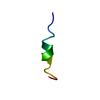
| |||||||||
|---|---|---|---|---|---|---|---|---|---|---|
| 1 |
| |||||||||
| NMR ensembles |
|
- Components
Components
| #1: Protein/peptide | Mass: 2133.540 Da / Num. of mol.: 1 / Fragment: C-Terminal region, UNP Residues 90-105 Source method: isolated from a genetically manipulated source Source: (gene. exp.)   Homo sapiens (human) / Gene: CCR2 / Production host: Homo sapiens (human) / Gene: CCR2 / Production host:   Escherichia Coli (E. coli) / References: UniProt: O95950, UniProt: P41597*PLUS Escherichia Coli (E. coli) / References: UniProt: O95950, UniProt: P41597*PLUS |
|---|
-Experimental details
-Experiment
| Experiment | Method:  SOLUTION NMR SOLUTION NMR | ||||||||||||||||||||||||||||||||||||
|---|---|---|---|---|---|---|---|---|---|---|---|---|---|---|---|---|---|---|---|---|---|---|---|---|---|---|---|---|---|---|---|---|---|---|---|---|---|
| NMR experiment |
|
- Sample preparation
Sample preparation
| Details |
| ||||||||||||||||||||||||||||||||||||||||||||||||||||||||||||||||||||||||||||||||||||||||||||||||||||||||
|---|---|---|---|---|---|---|---|---|---|---|---|---|---|---|---|---|---|---|---|---|---|---|---|---|---|---|---|---|---|---|---|---|---|---|---|---|---|---|---|---|---|---|---|---|---|---|---|---|---|---|---|---|---|---|---|---|---|---|---|---|---|---|---|---|---|---|---|---|---|---|---|---|---|---|---|---|---|---|---|---|---|---|---|---|---|---|---|---|---|---|---|---|---|---|---|---|---|---|---|---|---|---|---|---|---|
| Sample |
| ||||||||||||||||||||||||||||||||||||||||||||||||||||||||||||||||||||||||||||||||||||||||||||||||||||||||
| Sample conditions | pH: 6.5 / Pressure: AMBIENT / Temperature: 283 K |
-NMR measurement
| NMR spectrometer | Type: BRUKER AVANCE III / Manufacturer: Bruker / Model : AVANCE III / Field strength: 600 MHz : AVANCE III / Field strength: 600 MHz |
|---|
- Processing
Processing
| NMR software | Name:  CYANA / Developer: GUNTERT, MUMENTHALER / Classification: refinement CYANA / Developer: GUNTERT, MUMENTHALER / Classification: refinement |
|---|---|
| NMR representative | Selection criteria: lowest energy |
| NMR ensemble | Conformer selection criteria: target function / Conformers calculated total number: 100 / Conformers submitted total number: 20 / Representative conformer: 1 |
 Movie
Movie Controller
Controller


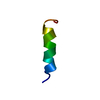
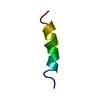





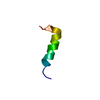
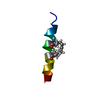
 PDBj
PDBj










